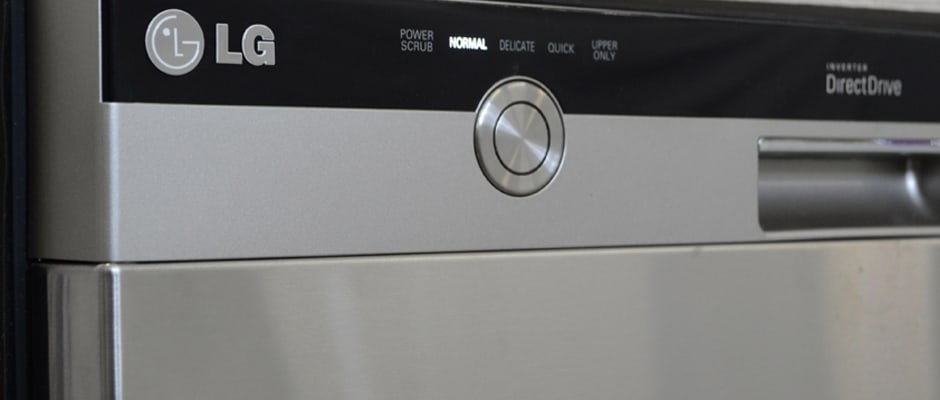Introduction
Design & Usability
{{section_header}}{{ section.name }}{{/section_header}}
Buttons? What are those?
The LDS5540ST has a very eye-catching control panel, which perhaps shouldn’t be a surprise coming from an LG product. Resting at the top of the stainless steel door, the front-facing controls features a big, circular button on the left side for selecting the wash cycle and a row of touch-sensitive depressions on the right side for additional wash options. It definitely looks like something you might find on a cellphone or television.
However, the controls are not without flaws. That big, shiny round button looks like a dial or directional pad, similar to ones found on portable music players or video games. It would even make sense here, as you could move your selection left or right as you decide which wash cycle you want. But alas, we were fooled. The button only does one thing: toggle among the five wash cycles, and only from left to right.
The touch-sensitive depressions were also pretty disappointing. Already lacking the tactile feedback of good, old-fashioned buttons, they also proved to be quite fickle. The circular grooves would sometimes register with a light touch, but sometimes required a harder press. Other times, it simply wouldn’t respond at all. We also found that yelling at it wouldn't work.
The two racks have a high degree of flexibility. On the bottom rack, every row of tines can be collapsed. You can even fold down only half a row, if that’s all it takes to make room for a large pot or a piece of unwieldy cookware. On the top rack, the angle of the tines can be adjusted or folded down entirely. Finally, a dishwasher that can fit even the wackiest of novelty cookware.
{{photo_gallery "Design Gallery"}}
Features
{{section_header}}{{ section.name }}{{/section_header}}
A large array of familiar options, plus something new.
The LDS5540ST has five cycles to choose from for a variety of washes. The Normal is for normal, everyday loads, Delicate handles your stemware, Power Scrub covers your pots and pans, Quick is your rapid cleaning option if you suddenly find yourself out of clean glasses while hosting a party, and Upper Only sprays just the top rack. While none of these are unique to the LDS5540ST, you won’t always find all of these on a single dishwasher, even in the $800 price range.
There are also a handful of additional cycle options to customize your wash. Sanitary adds a high-temperature rinse, Extra Rinse adds an additional rinse cycle to the current wash, and Extra Dry adds 60 minutes of extra drying time. There’s also a Delay Start that can be set from one to 19 hours and a Child Lock to block unintentional control inputs. Again, none of these are unique features, but you’d be hard-pressed to find all of them on one machine.
The feature that really makes the LDS5540ST stand out is Smart Diagnosis. Even with the best quality control, breakdowns and malfunctions are bound to occur to some people. If you're one of those unfortunate people, you simply call LG's customer service and hold the phone up to the appliance's speaker. The tiny speaker transmits data in the form of an audible tone, which is actually an error code to help identify the machine’s exact problem. The repair worker who gets deployed will have a wealth of information on the problem before even reaching your house, meaning more time is spent actually fixing the machine rather than figuring out why it’s not working. For more details on Smart Diagnosis and some other appliance innovations, check out this article.
Performance
{{section_header}}{{ section.name }}{{/section_header}}
Overwhelming power.
The LDS5540ST posted some inconsistent performance results, but did a good job overall. We ran the Normal, Heavy, and Quick cycles twice each, as part of the standard procedure for calculating our scores. For most dishwashers, the two passes of a cycle would have very similar results, but this was not the case with the LDS5540ST. On the first pass of each of these cycles, we would get a good, but not entirely awe-inspiring score. But on the second pass, the scores would be markedly better, with many more dishes coming out spotless, despite using the same amount of stains and detergent. Even disregarding the noticeable performance difference between each pass, the scores were all good, so there’s no denying the cleaning power of this machine.
The LDS5540ST’s performance with the spinach test was particularly noteworthy. Redeposit was noticeable on all three cycles, but not at egregious levels. Tiny flecks of spinach had migrated to almost every item we loaded, and though this is a common problem among dishwashers, this machine showed only a minimal degree of it. Spinach is a tough stain test that many dishwashers do poorly with, but the LDS5540ST’s Heavy cycle handled it quite nicely.
Lastly, the LDS5540ST had some pretty disappointing efficiency scores. Although water consumption rates were close to what we saw in other dishwashers we’ve tested, the amount of electricity this machine consumes for each cycle is higher. It also doesn’t help that the LDS5540ST takes its sweet time: even its “Quick” cycle takes over 90 minutes. All that extra juice adds up, and our number crunchers calculated an average annual cost of $37.53 for running this lightning rod. Perhaps we shouldn't be surprised that a machine that looks like it's from the future would be hungry for power.
Conclusion
{{section_header}}{{ section.name }}{{/section_header}}
A glimpse into the future.
If nothing else, the LDS5540ST is distinctive, both in terms of aesthetic design and technical wizardry. While the unique controls try to combine form and function, LG only got the first half of that equation down; you may find yourself frustrated by their unresponsiveness. As for technology, Smart Diagnosis is a welcome step toward a future where appliances fix themselves. None of the extra bells and whistles seem to interfere with overall performance, so if you don’t mind the longer cycles and higher energy costs, the LDS5540ST’s cleaning power alone may make this a worthwhile purchase for you.
Introduction
{{section_header}}{{ section.name }}{{/section_header}}
The LG LDS5540ST looks like something from the future. Therefore, it is our duty as scientists to dissect it and analyze it, and then eventually give it sentience and the ability to turn on its creators. Our tests showed that this dishwasher terminates dirt pretty well, but at the cost of your electric bill. The unsurprising result is great performance scores balanced by poor efficiency scores.
Performance
{{section_header}}{{ section.name }}{{/section_header}}
The Power Scrub cycle delivers a heavy beating.
As mentioned in the full review, the LDS5540ST did a good job overall. Even with the differences between the two passes of the same cycle, most of the soils were removed. This even included most of the spinach, and what’s even more impressive was how little of it got sprayed on to the other dishes. Generally, the quicker the cycle, the worse it performed, but none of the scores were disappointing.
The LDS5540ST’s Power Scrub cycle is a real bruiser, taking out nearly every stain we threw at it. Even the baked-on lasagna and burnt cheese were removed, but there was a little trouble with the burnt sugar. The amount of time and electricity this cycle consumes is a bit prohibitive, meaning you’ll only want to use the Power Scrub for the dirtiest of jobs.
{{photo_gallery "Performance Gallery"}}
Efficiency
{{section_header}}{{ section.name }}{{/section_header}}
Your wallet will feel it, too.
The LDS5540ST is an expensive machine to run. Much of that has to do with the long cycle times and the large amount of electricity consumed. The Normal cycle, the one you are expected to use most often, consumed a whopping 0.97 kWh of electricity. We’ve seen Heavy cycles on other machines that didn’t even use that much. Combined with water costs, we’re estimating that each Normal run will cost you about 15 cents. The Power Scrub is the worst offender, using 8.35 gallons of hot water and 1.49 kWh of electricity, adding up to a cost of 27 cents per run. If you are concerned about your utility costs, the LDS5540ST may not be your top choice, as we’ve estimated the annual running cost to be $37.53.
{{photo_gallery "Efficiency Gallery"}}
Capacity
{{section_header}}{{ section.name }}{{/section_header}}
Highly adjustable and plenty of space.
The LDS5540ST is quite roomy and highly adjustable. We were able to fit 11 place settings and a serving setting. As mentioned in the full review, every row of tines on the bottom rack could be folded down. The high degree of adjustability combined with the spacious interior makes it possible to fit just about anything.
{{photo_gallery "Capacity Gallery"}}
Meet the tester
Johnny Yu is a former news and review writer for Reviewed.
Checking our work.
Our team is here to help you buy the best stuff and love what you own. Our writers, editors, and experts obsess over the products we cover to make sure you're confident and satisfied. Have a different opinion about something we recommend? Email us and we'll compare notes.
Shoot us an email

